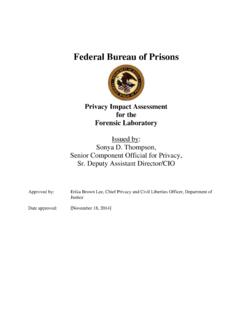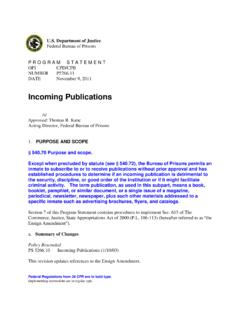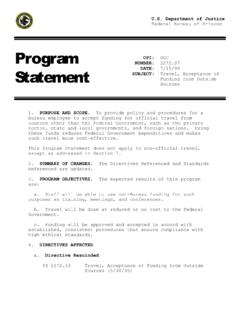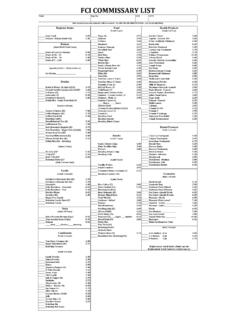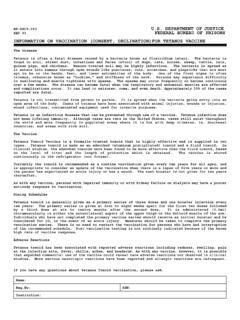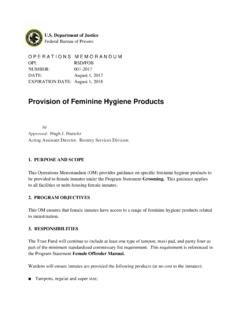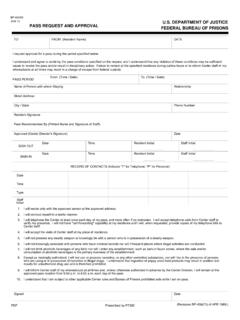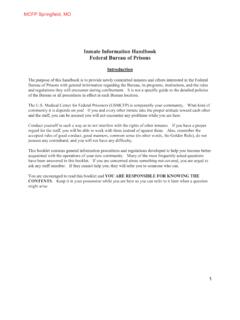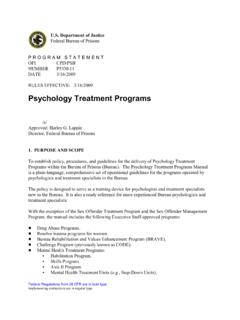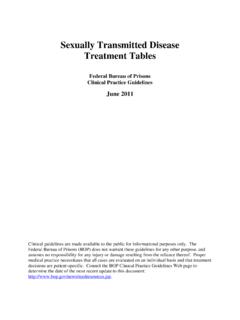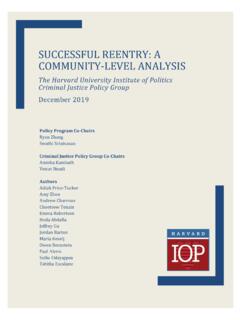Transcription of KEY COMPONENTS OF THE - Federal Bureau of Prisons
1 August 2019 1 KEY COMPONENTS OF THE Federal Bureau OF Prisons CURRENT NEEDS ASSESSMENT SYSTEM The Federal Bureau of Prisons (BOP) begins focusing on inmate reentry on an inmate s first day of incarceration. Pursuant to this concept, the BOP conducts a variety of assessments early in the admission cycle, in order to identify and provide programs and services to prepare inmates for their eventual reentry to society following completion of their sentence. Assessing each inmate s individual needs to improve reentry outcomes is an integral part of this preparation process. Sentenced inmates arrive at their BOP institution for service of their Federal sentence needing some or all of the following: career and technical education, literacy, mental health treatment, health care, and other assistance such as treatment for substance use disorders, parenting skills, and linkages to community resources for continuity of care. The BOP assesses sentenced inmates at intake and throughout their term of incarceration in an effort to identify both ongoing individual risks and needs.
2 This process includes the completion of a series of interviews and/or tests or questionnaires, the results of which are translated into individualized recommendations. The recommendations are discussed with the inmate, who agrees to them and signs a Needs Plan. To enhance and support this process, the BOP developed an integrated web-based application Insight that allows ongoing, multidisciplinary reviews of each inmate s progress toward established goals and recommended programs, as well as the electronic storage of those plans. This system also provides progress summaries to our law enforcement partners, such as the United States Probation Office, that will assist with the inmate s transition to the community. The BOP assesses an inmate for a variety of needs in determining how to best assist inmates in their self-improvement process and prepare them for reentry . This document summarizes the primary areas in which the BOP assesses needs and provides programming to address these areas.
3 CRIMINOGENIC NEEDS The risk-need-responsivity model identifies eight needs (four major and four minor). The four major needs address antisocial issues including cognition, behavior, associates, and personality. Each of these needs are assessed indirectly via both interview and file review (including reading of the Presentence Investigation Report) by the inmate s Unit Management Team. From this information, referrals are made for the inmate to participate in Cognitive Behavioral Therapy (CBT) programs such as anger management or criminal thinking elimination/cognitive skills, as well as to other programs that can help the inmate build healthier relationships or make more prosocial behavior choices. August 2019 2 EDUCATION/VOCATIONAL NEEDS METHODS OF NEEDS ASSESSMENT: EDUCATIONAL TESTING (TABE / CASAS) Upon an inmate s admission, the BOP conducts a comprehensive review of an inmate s educational status and confirms his or her educational credentials.
4 To the maximum extent practicable, collateral documentation of educational credentials are reviewed ( , verification of high school diploma). Pursuant to 28 CFR , an inmate confined in a Federal institution who does not have a verified General Educational Development (GED) credential or high school diploma is required to attend an adult literacy program for a minimum of 240 instructional hours or until a GED is achieved, whichever occurs first. Per Program Statement (PS) Minimum Standards for Administration, Interpretation, and Use of Education Tests, the BOP administers the Test of Adult Basic Education (TABE) to inmates without a confirmed high school diploma or a high school equivalency (HSE) certificate in order to place inmates at an appropriate instructional level. Once placed in the appropriate instructional level, if an inmate is identified or suspected to have a disability that would hinder his or her learning capacity, BOP staff administer the Woodcock Johnson IV to best identify the area of need (see also Program Statement Management of Inmates with Disabilities ).
5 This assessment also aids BOP staff to ensure appropriate accommodations (classroom and testing), interventions, or modifications can be provided to enable a level learning environment for all inmates. The BOP also assesses non-English proficient inmates for English proficiency skills. A non-English proficient inmate must demonstrate he/she can read and understand English at the eighth grade level. In accordance with 18 3624(f), limited English proficient inmates confined in BOP institutions are required to attend an English-as-a-Second Language (ESL) program until they function at the equivalence of the eighth grade level in English competency skills. The BOP uses the Comprehensive Adult Student Assessment System (CASAS) tests to assess an inmate s English language proficiency level. CASAS tests measure two skill areas: reading and listening comprehension (understanding the spoken English word). For inmates with a high school diploma or HSE certificate, the TABE may also be used to assess literacy levels for placing the inmate in vocational programs.
6 The results of education assessments and identified education needs are used to place inmates in appropriate literacy programs, with accommodations provided as needed. VOCATIONAL AND OCCUPATIONAL TRAINING Vocational and occupational training programs are offered and available at every non-administrative BOP facility. These training programs are assigned based on the needs of the inmates, general labor market conditions, and institution labor force needs. An important component of these training programs is on-the-job training, which inmates receive through institution job assignments or work in Federal prison Industries. The BOP also facilitates post-secondary education in vocational and occupationally oriented areas by partnering with local community educational or vocational resources. A full list of the BOP s national programs can be found on the BOP s public website. August 2019 3 MENTAL HEALTH / TRAUMA NEEDS (PSYCHOLOGY INTAKE) All BOP Psychology Services Departments provide mental health care for inmates consistent with professional standards and best practices in correctional psychology (see PS Psychology Services Manual , and PS Psychology Treatment Programs ).
7 This care includes the assessment and treatment of a wide range of mental disorders. All inmates undergo a Psychology Intake Screening interview, conducted by a doctoral-level psychologist, to ensure that inmates with mental illness are identified and receive treatment to assist their progress toward recovery. The BOP s mental health protocols, standards, and guidelines are designed to support the inmate s mental health, while reducing or eliminating the frequency and severity of symptoms and associated negative outcomes of mental illness. RECOVERY-ORIENTED PROGRAM MODEL Consistent with the recommendations of the President s New Freedom Commission on Mental Health, the BOP has identified recovery as a guiding principle in the treatment and care of inmates with mental illness (see PS Treatment and Care of Inmates with Mental Illness ). The goals of mental health recovery treatment are to ensure that inmates are able to live, work, learn, and participate fully in their communities.
8 For some individuals, recovery is the ability to live a fulfilling and productive life despite a disability. For others, recovery can mean the reduction or complete remission of symptoms. There are ten fundamental COMPONENTS of recovery under the National Consensus Statement on Mental Health Recovery. The BOP strives to integrate these COMPONENTS into its Psychology Treatment Programs, mental health interventions, and treatment plans for inmates with mental illness. A variety of CBT programs are offered that address both mental health and the aforementioned criminogenic needs. They vary in dosage and intensity, from short outpatient groups to years-long residential programs. SUBSTANCE ABUSE The psychology intake process is also the initial means of determining the presence of a substance use disorder. Per BOP policy (see PS Psychology Services Manual and PS Psychology Treatment Programs ) , BOP psychologists conduct screening interviews on all newly admitted inmates.
9 Additionally, inmates may be screened at additional points due to identified substance abuse or their eligibility for specific interventions. Inmates with identified substance use disorders are referred to the BOP s treatment programs. Their need for substance abuse treatment is documented in their clinical record and relayed to their Unit Management Team. In addition, all inmates meeting criteria for referral to the Drug Education Course (described below) are given a drug education requirement by their Unit Management Team. The need to participate in the Drug Education Course is also documented in the inmate s Need Plan. August 2019 4 IN-CUSTODY TREATMENT PROGRAMS A multi-faceted treatment delivery system accommodates the entire spectrum of inmates in need of substance abuse programs. This delivery system includes the Drug Abuse Education (DRG ED) Course, the Non-Residential Treatment Program (NR-DAP), the Residential Drug Abuse Programs (RDAP), and the Medication-Assisted Treatment (MAT) program.
10 DRG ED is an evidence-based education course designed to motivate inmates with an identified need to participate in non-residential or residential drug abuse treatment as needed. DRG ED is available in each of the BOP s 122 institutions. In FY 2018, nearly 23,000 inmates participated in DRG ED. In addition to DRG ED, NR-DAP is also evidence-based and available in each of the BOP s 122 facilities. It builds on the motivation generated by DRG ED by providing CBT interventions in a non-residential setting. The specific populations targeted for non-residential drug abuse treatment include inmates who request and volunteer for treatment, but do not have sufficient time remaining on their sentence to complete the RDAP. It also includes inmates with longer sentences who are in need of treatment and are awaiting placement in the residential drug abuse program. In FY 2018, nearly 15,000 inmates participated in NR-DAP. The RDAP is based on CBT provided in a modified therapeutic community model of treatment.
